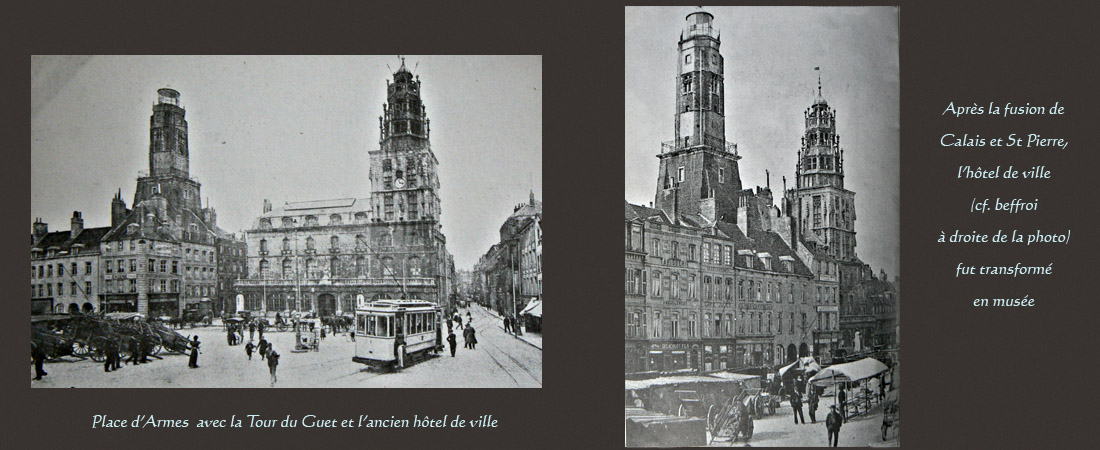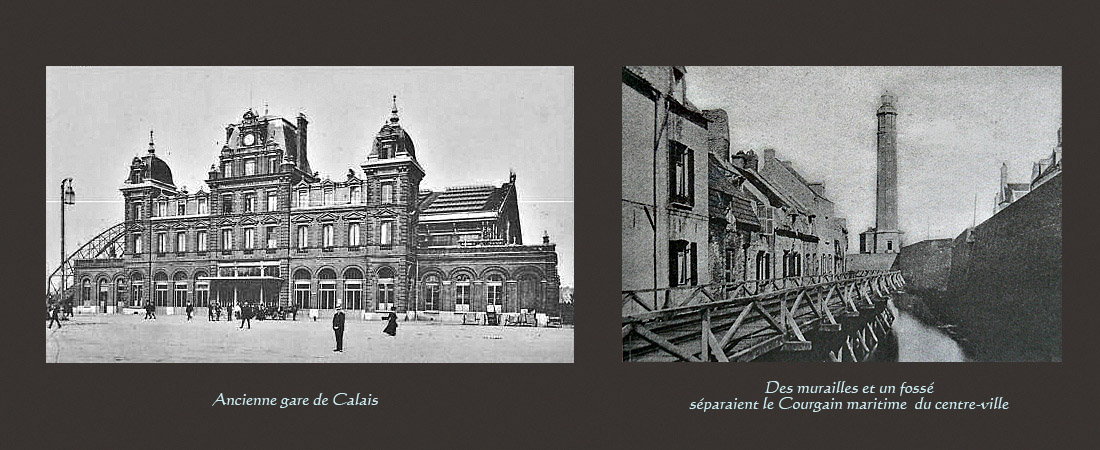Historical highpoints
Summary
The merger of Calais and Saint-Pierre
A city battered by the two world wars
The origin of Calais
The drying of soils…
We know little about the peopling of Calais, except that it was rather late. During the Neolithic period (7500-3000 BC.), while the man begins to settle, Calais is still under water. The Blanc-Nez cap, composed of limestone ... hence its name, overlooking 130 m above sea level and about ten kilometers below the town of Calais. He is a real cap on the end of the western continent.
Lime deposits deposited by the sea gradually extend the limit of the continent. However, Calais remains long a wetland which will determine the subsequent position of the various forts built on land. Even today, one can notice around Calais and many watergangs and soils below the sea level that remind us that the city was built on land reclaimed from the sea.
The Morini …
Before the arrival of Roman legions in Belgian Gaul in 57 BC, Calais was occupied by the Morini. These descendants of the Cimbri and the Saxons, whose name of Celtic origin "Mor" means "sea", lived mostly along the coast but had its capital city of Thérouanne. This barbaric and lawless people knew, however coalition with its neighbors to confront the enemy. Julius Caesar and took six years to submit, and, leaving the privileged classes, druids and noble privileges.
About Julius Caesar…
The Romans dominated the region for almost five centuries, until 446, date Clodion, king of the Franks reconquered the region. Roman religion was replaced the barbaric rites. The Romans cleared uncultivated soil, dried up swamps and permanently changed the coastal landscape. We then began to cultivate the land and to develop maritime trade.
A village of sailors…
In the nineteenth century, Calais was essentially marine huts built along the waterfront. The natural first port is improved by order of the Count of Flanders, Baldwin IV.
The birth of Calais…
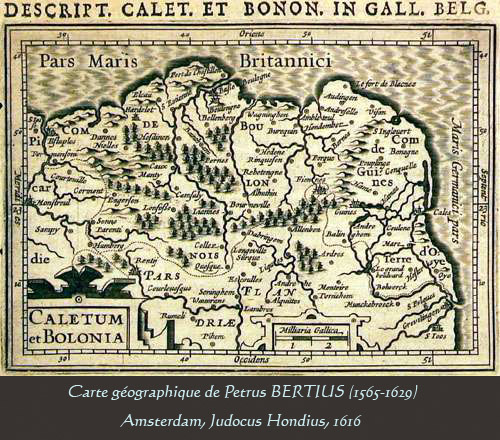
According to the times, the town bore different names. The above map, representing part of the Belgian Gaul in 1616, refers to Calais by Caletum. This name would itself originated Calesium and Calitius, "Ca (s)" means the platform, place or port (Saxon), and "Itius" the same port name.
It is also found to designate Calais: Cales in West Flemish, or Kales, Dutch, and Kaleis, in Old French..
The first municipal charter officially founding the city was issued in 1181 by Mathieu of Alsace, Count of Boulogne (1137-1173).
A strategic port…
Very quickly, the position of Calais, considered very strategic, will be strengthened to counter the Nordic and English invasions.
n the ninth century, the port is defended by two large towers: one, northeast of the city, was built by the Emperor Caligula, the second, northwest of the city, by Charlemagne in 810. These two rounds respectively gave rise to Risban fort and the castle disappeared from the sixteenth century but which gave rise to the current Nieulay fort.
From 1240, Calais, previously managed by the counts of Flanders and Boulogne-sur-Mer, directly reaches the area of Louis IX (Saint Louis, 1226-1270).
The English occupation
The context of the Hundred Years War
When in 1346 the English King Edward III decided to take Calais, one of the longest and bloodiest medieval wars, the Hundred Years War, raged. This dark period of history, punctuated by unrest, epidemics (The Great Plague of 1348), fights and brief truces, was in fact against France and England for 116 years, from 1337 to 1453.
Officially, it is for Edward III to claim the French throne following the difficult succession in 1328 (see Genealogy direct Capetians) Capétien of Charles IV the Fair (third son of Philip IV and younger brother of Isabelle de France the wife of Edward II of England). Edward III highlights its legitimate line as nephew of the king of France deceased. It is thus opposed to his two cousins, other pretenders to the throne :
- the future Philippe VI, Count of Valois, son of Charles of Valois, the younger brother of Philip IV ;
- Philippe d'Evreux, grand-son of Philip the Fair III, who married his cousin Joan of Navarre (daughter of Louis X Hutin, eldest son of Philip the Fair III).
Another element prompts the English sovereign to fight France: its determination to defend and even expand its British possessions on the continent: Normandy, Anjou and Aquitaine. These territories are English since 1152, year of the marriage between Eleanor Duchess and Prince Henry II Plantagenet.
During the Hundred Years War, Britain will experience a number of victories, and before including the arrival of Joan of Arc who will drive the English from Orléans in 1429, a date that marks the beginning of a turnaround ... although it will itself betrayed and burned alive in Rouen in 1431. This turnaround will however leave Calais side for many decades yet…
A strategic challenge: Calais
In 1303, Philip IV increases the fortifications of the city and team are a large number of vessels. During the 1320s, attacks by the french fleet multiply against english vessels developed to undermine maritime trade to english ports.
In addition, rampant pirates on the coast. Thus, in 1321, the Calais's corsair Bérenger privateer seizes a Genoese ship full of supplies to England. This vessel will never be delivered to its recipient…
Also, in the heart of the war is doubly strategic possess Calais for England again become master of its territorial waters and create a military base on the French coast.
In 1346, after having invaded Normandy, the English king, impressed by French forces mobilized, decided to withdraw to Crécy (north of Abbeville in the Somme) to rest his troops and to organize against the enemy. Despite their numerical weakness, the English dominate and prevail (use of bombards and many archers).
Encouraged by this victory, Edward III decided that the time has come to conquer the city of Calais, he truly considers the Key to France.
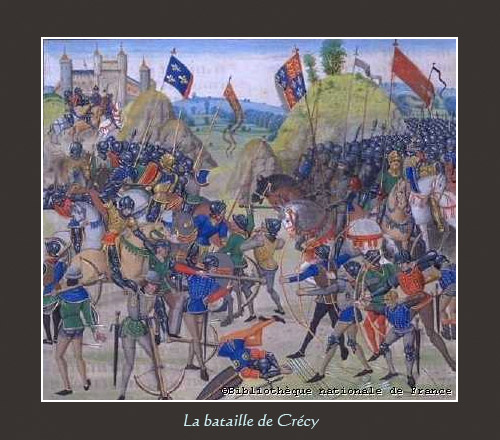
The siege of Calais
In August 1346, British troops are approaching Calais. Soon, Edward III understands that he will fail to capture the city protected both by its ramparts, the sea and the sandy and marshy tracts. He decided to starve the population by introducing a seat. Also, it made arrange a real town just outside Calais, on an area called the Pierrettes, where thousands of British troops are encamped.
To conserve resources, the governor of the city, Jean de Vienne, made from 1700 useless mouths. But when the seat turns into a total blockade, land and sea, the population in Calais literally starving.
July 27, 1347, Philip VI of Valois decided to rescue the people of Calais and gathers 60,000 soldiers to the tune of Sangatte. But the enemy entrenchments show him the terrain and defensive measures taken by Edward III make it impossible to attack. To the dismay of the population, King Philip VI of France broke camp.
Hungry and desperate, people went.
The terms of surrender
Edward III, very irritated by the seat expensive in lives and money, has one wish: to destroy the city. Wish that everyone around him disapprove (the mediator designated by Edward III, Walter Manny who invited him to consider the negative consequences of such severity that it could incite the enemy to adopt the same attitude when next fights, especially as the population has committed the "crime" of wanting to defend his king). Edward III thus gives.
The truth about the conditions imposed by Edward III to spare the population differs according to chroniclers of the fourteenth and fifteenth centuries. History has mostly retained the most fictionalized version of Froissart, professional writer (1330, Valenciennes, died between 1404 and 1408), who lived with wealthy patrons. The latter is based on the canon of the story and historian Jean Le Bel (1290, Liège-1370) and reported that the English sovereign would have required him that book six bourgeois among the most illustrious notables of the city, "barefoot and the halter and the keys of the city and the Castle in their hand ".
This humiliating condition having been brought to the attention of Calaisiens, Eustache de Saint-Pierre, the richest citizens of the town, devotes the first:
"Lord, it would be great misfortune to let such people die here of hunger when we can find another way. I have so much hope to find grace and forgiveness of our Lord if I die to save the people, I want to be first; I willingly put myself in his shirt, bareheaded, a halter, thank you to the King of England ".
While men and women throw themselves at his feet in tears to thank him, five other Calaisiens soon follow: Jean d'Aire, the cousin Eustace, the brothers Jacques and Jean de Wissant, Jean de Fiennes and Andrieus Andres.
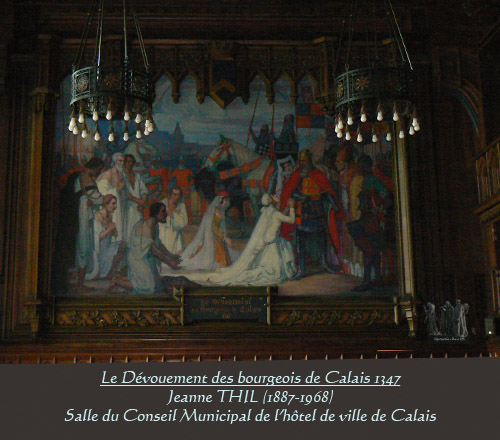
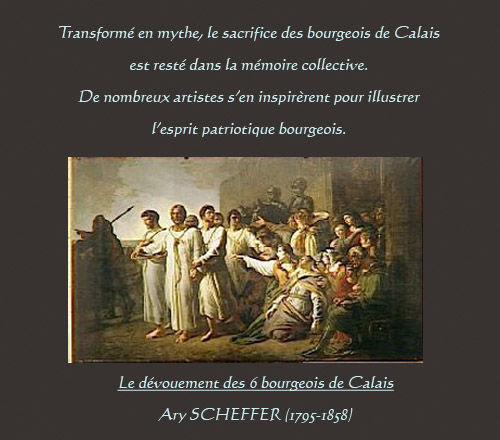
The bourgeois dedication
Also according to Froissart, August 3, 1347, the bourgeois Six emaciated appear before the monarch with the keys to the city, kneel imploring the grace of the English sovereign.
Edward III, insensitive to this magnanimity command that leads them to the executioner. Froissart (protégé of the Queen which he praises the generosity) also reports that the wife of the king, Philippine (or Philippa) Hainaut (linked to France: great granddaughter of Philip III the Bold through his mother Jeanne de Valois, (see genealogy direct Capetians), pregnant, rushed to her husband's feet and begs him not to sully his glory by the death of these unfortunate. the king agrees.
August 29, 1347, day of the surrender of Calais, the king and queen entered the city. After bringing food carts, the king expelled the Calaisiens to prepare restocking by English subjects.
It is said that despite the generous provisions of King Philip VI of France who wanted to reward the loyalty and heroism of the people of Calais by providing funds to live, most of them wandered the roads of the kingdom, reduced to most terrible poverty…
The direct impact of the British occupation of the city
The British, anxious to strengthen the defenses of the city, consolidate and develop the fortifications (see page on fortifications). They operate drying of flood zones, are building hotels and magnificent houses around the castle (the current location of Fort Nieulay), enlarge the Notre Dame church, develop trade in the city, shall adjust its port.
In 1348 Edward III established a warehouse in Calais all English goods to its allies on the continent. In 1349, the boat captains also are instructed to prefer the port of Calais in any other.
In 1397, one proceeds to the desilting basin of Paradise.
The city is experiencing a prosperous period and regularly hosts English kings and nobles which reinforces the prestige of the city. Besides the attraction of English for Calais remains today.
The Liberation
While the Hundred Years War has been over for more than a century, Calais is still a possession of the English Crown is particularly keen to preserve this last territory on the mainland. To defend the city, it relies on two main elements, strengthened its fortresses and its very favorable geographical location.
Indeed, Calais looks stunning not only through its walls, but also because it is surrounded on all sides by either the waterfront or not wetlands or streams.
Calais impregnable? Its castle northwest is more vulnerable than it seems: the towers are hollow, its speakers are not consolidated by solid earth-, and the castle looks north towards a ditch and a sandbank completely covered during high tide.
Thus, in 1557, to recover Calais, King Henry II of France, assisted by Jean MONCHY DE SÉNARPONT, governor of Boulogne and master in the art of fortification, will develop campaign plans that the Duke of Guise will run.
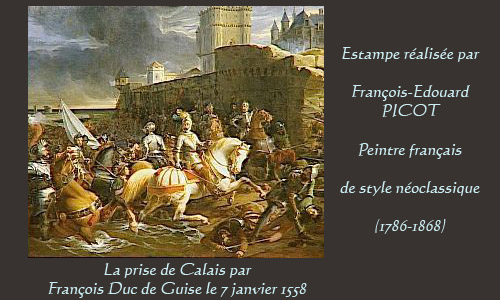
From the beginning of 1558 year is the first fortress of Sangatte (north west of Calais), then the strengths and Nieulay Risban falling. This fort placed in front of the French port allows vessels to land arms, soldiers and supplies.
The Duke of Guise then distracts English by a false attack and seized the most advanced of the castle tower.
The garrison surrendered on January 7, 1558. The common soldiers and bourgeois retired without arms or money or luggage in the Netherlands. The governor, Lord Wentworth, and officers remained POWs.
So the city was taken over in just seven days when the English had taken a year and 28 days to conquer, but it was 210 years ago ...
The arrival of English lace
Prochainement en ligne !
The merger of Calais and Saint-Pierre
Prochainement en ligne !
A city battered by the two world wars
A wounded city during the First World War
Calais during World War II, is far from the front and the fighting that bloody Artois, however, the military presence is massive, the Belgian headquarters is housed there. During the four years of the conflict, millions of soldiers will pass through Calais and Boulogne. The city turned into a fortified camp houses even more soldiers than civilians, not counting the thousands of sick and injured evacuees crammed into Belgian hospitals.
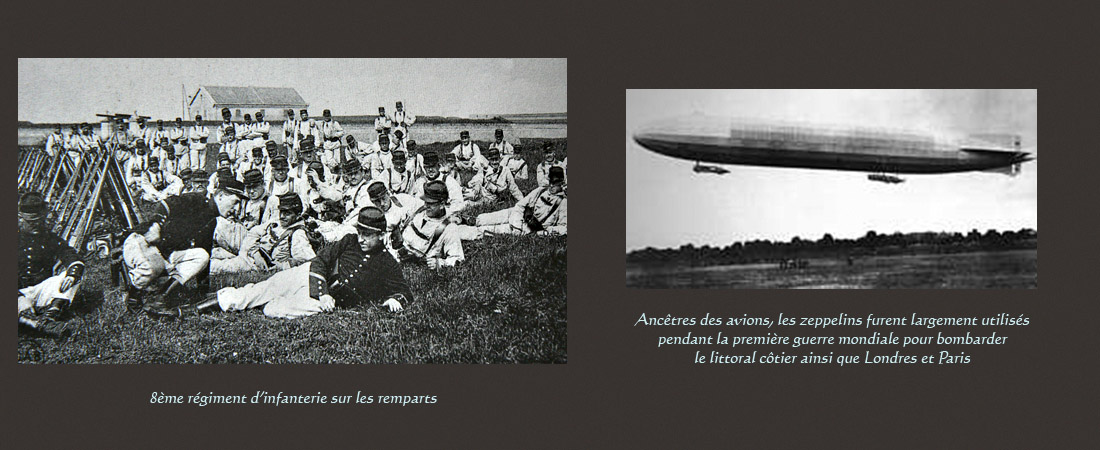
Also the city is a prime target for the Germans: cosmopolitan, it is an international basis (in addition to French troops, British soldiers, Belgian and Portuguese and American) and a supply depot, it is the most bombed city from the rear.
Indeed, with the innovations of the war, became industrial, Calais will undergo aerial bombardment of Zeppelins causing serious material damage (destroyed or damaged houses), 270 killed and 528 wounded. In addition to the railways, the Church of Our Lady and the Belfry brand new City Hall are damaged.

Also, when World War II broke out, the city is still bruised from the previous conflict.
Calais: a field of ruins during World War II
May 10, 1940: Hell advance inexorably. The Wehrmacht invaded Belgium and Holland, the Luftwaffe attacks the railways and towns, Calais is the first hit at 5:20.
From 16 May, the population is thrown on the exodus roads.
While German armored advance relentlessly towards Dunkirk, Boulogne after May 25, 1940, Calais, bombed, is the prey of a deluge of fire and flames for 15 days and falls on May 26 after a heroic resistance that lasts three days and three nights after which the Allies (British, French, Belgian and Dutch), having exhausted their ammunition, were forced to surrender.
Old Calais (Calais-Nord) is nothing but a heap of smoking ruins where only the lighthouse, the Frauenkirche and the Watch Tower, although it was damaged, remained standing; the Watch Tower, the oldest monument in Calais who resisted the Norman invasions, several earthquakes (May 21, 1382, April 23, 1449, 1580 and 28 November 1776), will therefore be the silent witness of an occupation which will last four years ... the historic district of Courgain disappeared and much of the population fled the fighting.
Old Calais saw disappear under the bombs its old town hall with Flemish style belfry converted into a museum, the parade ground surrounded by mansions, city walls that encircled the ancient city…
Time for Occupation
The departments of Nord and Pas-de-Calais, separated from the rest of France, are attached to Militärbefehlsaber (military command) Brussels and are placed in "restricted area", very special status as they may annexation to the Reich.
Calais lives since the German time whose only remnant is the current Malo Bunker almost 100 meters long (now 1962 War Museum) in the heart of Saint-Pierre Park, command post of the Navy German and central war.
The Calais's life becomes that of any occupied France: rationing, ration cards, curfew, STO.
Liberation under the bombs ...
And then the time of the Liberation finally arrives on October 1, 1944, and as Royan, Calais was bombed again by the Allies this time, but by mistake, February 27, 1945 !
In Tuesday 27 February, the streets are buzzing with people, children school power out, abandoning the Calaisiens offices and workshops to regain their homes. A day of peace almost found despite the still difficult conditions since it is necessary to refuel with the power board. In this hubbub of late afternoon, no one is surprised to hear the roar of engines squadrons in the sky. But suddenly, within a few seconds, a picnic device and shrapnel ripped the city in a terrible explosion ... the dead littering the streets. In the Saint-Pierre district (the Valencia street to the Gaillard Street, Lafayette Boulevard at Curie Boulevard), 89 dead bloody streets, blown by the explosion, sometimes beheaded.
The next day, the mayor, Jacques Vendroux, visited by both British and American officers, rushed to express regret General Eisenhower: three squadrons of 2nd Tactical Air Force had taken off from Vitry-en-Artois for a mission over of Dunkirk pocket; if the first two squads have preferred to turn back because the sky increasingly clogged, the third on the other hand continues its mission ... If the first training (6 Mitchell) achieved its target to 16 hours and drops his bombs, the second (6 other Mitchell) seeks its objective and believes he has finally found. It is 17:30, 40 bombs fall on Calais ... 89 dead and 200 wounded in the latter allied bombing.
The funeral took place in the afternoon of 3 March, the honors are given to victims by the Royal Air Force. Led by a British military band, the coffins were carried to the cemetery in 10 trucks loaned by the British army. And it is March 4 that people learn through the press the official press. The Calaisiens bruised once again welcome these official regrets in a dignified silence.
At the end of these four years of war, Calais then offers a lunar landscape marked by cracks left by shrapnel, the rutted fields mingling debris son of iron, pieces of walls. No roads and no place is recognizable; everything was pulverized. The city is only a vast expanse of devastation and desolation.
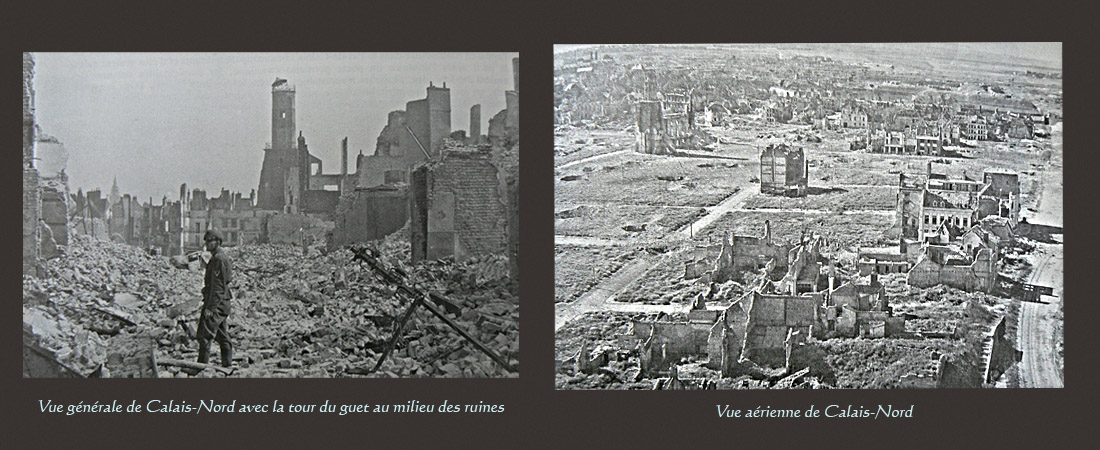
It was then time for the reconstruction, it will take 15 years.
Main buildings destroyed
